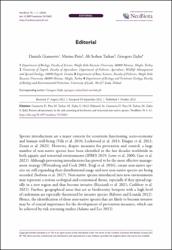Editorial
Citation
Giannetto D, Piria M, Tarkan AS, Zięba G (2022) Editorial. In: Giannetto D, Piria M, Tarkan AS, Zięba G (Eds) Recent advancements in the risk screening of freshwater and terrestrial non-native species. NeoBiota 76: 1–11. https://doi.org/10.3897/neobiota.76.93602Abstract
Species introductions are a major concern for ecosystem functioning, socio-economy and human well-being (Vilà et al. 2010; Lockwood et al. 2013; Diagne et al. 2021; Zenni et al. 2021). However, despite measures for prevention and control, a large number of non-native species have been identified in the last decades worldwide in both aquatic and terrestrial environments (IPBES 2019; Lowe et al. 2000; Guo et al. 2021). Although preventing introductions has proved to be the most effective management strategy (Wittenberg and Cock 2001; Pergl et al. 2016), extant non-native species are still expanding their distributional range and new non-native species are being recorded (Seebens et al. 2017). Non-native species introduced into new environments may represent a serious ecological and economical threat, especially if they spread rapidly in a new region and thus become invasive (Ricciardi et al. 2021; Cuthbert et al. 2021). Further, geographical areas that act as biodiversity hotspots with a high level of endemism are especially threatened by invasive species (Ribeiro and Leunda 2012). Hence, the identification of those non-native species that are likely to become invasive may be of crucial importance for the development of prevention measures, which can be achieved by risk screening studies (Adams and Lee 2012)


















